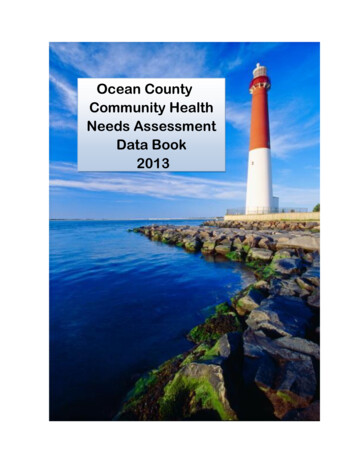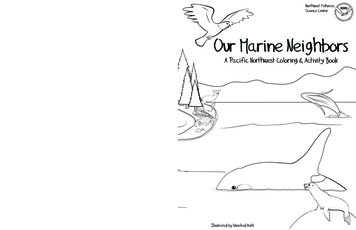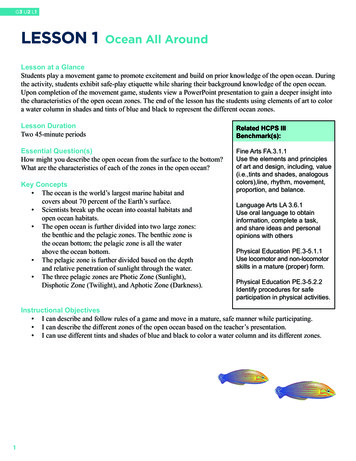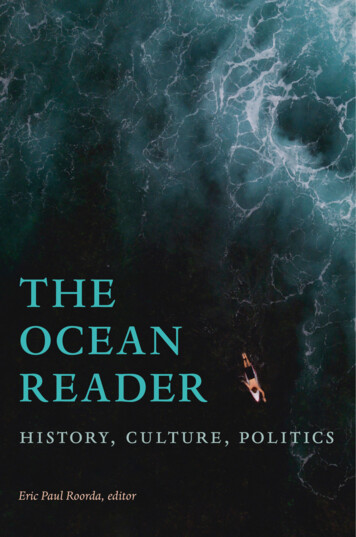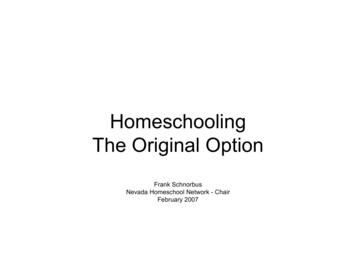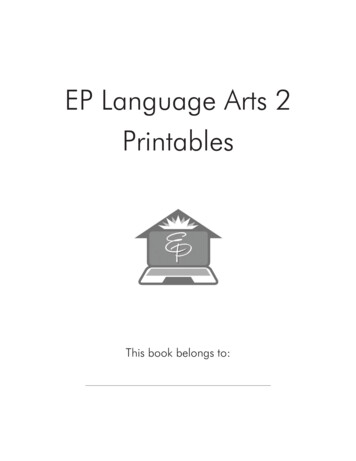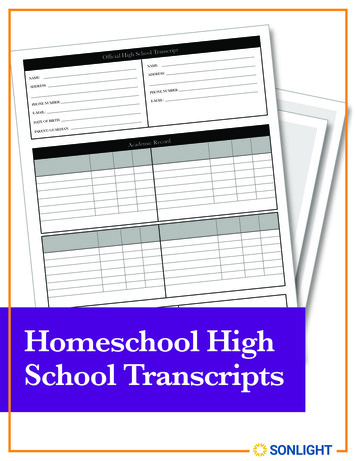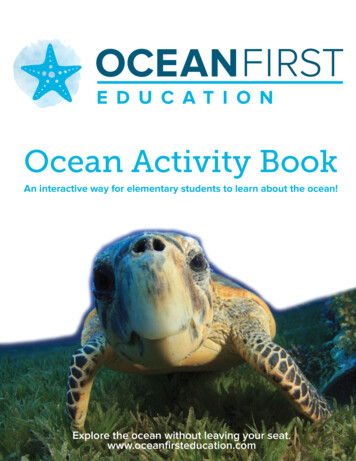
Transcription
Ocean Activity BookAn interactive way for elementary students to learn about the ocean!Explore the ocean without leaving your seat.www.oceanfirsteducation.com
What is the Ocean?The ocean is a large body of saltwater that covers 71% of the Earth; that’smore than half of our planet! Many different plants and animals live in theocean. Although there are five named oceans, nothing separates themfrom each other and the seawater flows freely all around the globe.Create your own ocean view by drawing your favorite oceancreatures in the space below.-1-
Name the OceansWrite the names of the five oceans on the map RALIAANTARCTICAHere are a few hints to help you along.Atlantic Ocean - This ocean is located between the Americas and AfricaArctic Ocean - This ocean is found at the very top of the worldIndian Ocean - This ocean is located south of Asia, east of Africa, andwest of AustraliaPacific Ocean - This ocean is found to the left of the Americas and to theright of Asia and AustraliaSouthern Ocean - This ocean surrounds the southern-most continentDid you notice how all of the water flows together? There are no barriers toseparate the oceans. Just imagine being able to swim all around the world!Which ocean is closest to your house?-2-
Underwater PlantsYou’ve probably walked on grass at school, at the park, or on your own frontyard, but did you know there are plants, just like the grass on the ground,that live in the ocean? Green plants, like what you see growing out of theground, get their energy to live and grow from the sun. The plants that live inthe ocean do too! Mangrove trees, sea lettuce, and sea grass grow underand near the water, but they also need the sun to grow! There are also algaethat grow in the sea. Algae, like kelp and seaweed, are very similar to plants,but they are not plants. Algae rely on the sun for their energy to grow, butthey have different parts than plants do!P - Plants are green, but can be shades of purple, red, and yellow too!L - Long leaves or short leaves, they all need the sun.A - Air, water, nutrients, and sunlight are needed.N - Nibbling animals find plants delicious, yum!T - Tall or short, plants grow up from the ground.S - Sunshine helps all plants grow!A - Along the water’s edge is where you’ll find it.L - Like a plant, but not exactly the same.G - Green, red, and brown are the colors it comes in.A - Attached to rocks and the sea floor, it sways in the waves.E - Eaten by snails, sea turtles, and crabs!Can you come up with your own poem about plants, seaweed, oralgae? Give it a try in the space below.-3-
What Belongs in the Sea?Plants on land are a little different from plants in the ocean.Look at each pair of plants below, then circle the one thatbelongs in the sea!GrassManatee GrassRed FlowerRed AlgaeHalamedaFernSea LettuceBibb LettuceKelpCorn StalkSproutsSargassum-4-
Who Has a Backbone?There are many animals that live in the ocean and most of them don’t have abackbone! What’s a backbone? Take your right hand and reach around to yourback all the way to the middle. Can you feel that line that goes up and downthe middle of your back? That’s your backbone. You have one, each of yourparents have one, every dog, cat, and fish has one, but there are many animalsthat don’t. Animals that don’t have a backbone are called invertebrates. Thingslike earthworms, butterflies, and bees are invertebrates that live on land.Maybe you have eaten a few invertebrates that live in the ocean! Animals likeclams, crabs, shrimp, lobster, and oysters are all invertebrate animals - youwon’t find a backbone among them! Invertebrates look pretty different fromanimals with a backbone.All of these animals are found in the sea.Circle the invertebrate animals. (The ones without a backbone.)sharknudibranchangelfishspongesea nlobstersoft coralseastarmanatee-5-
In the space below, draw your favorite vertebrate animal.(One that has a backbone, like you!)In the space below, draw your favorite invertebrate animal.(One that does not have a backbone.)-6-
Vertebrates Like You!If you are not a plant or an invertebrate, then you must be a vertebrate!Vertebrates are animals with a backbone just like you! Whales, manatees,dolphins, sea lions, sea otters, walruses, sharks, sea turtles, and every fish in thesea is a vertebrate animal. They all have a backbone. Having a backbone makesit possible for the animals to grow very, very - and in some cases like the bluewhale - VERY large.Can you figure out the different vertebrate animals from the clues to completethe crossword puzzle? There is a word bank to help you, just in case.Across4. This animal is black and white andis the largest member of the dolphinfamily.Down1. The mouth of this fish looks big andsharp like a type of bird, but it doesn’teat fruit like the bird, it eats coral.5. Although it looks like a dog, it hasfour flippers instead of four legs.2. This animal has an endlessconveyor belt of teeth to replace theones it loses while eating.6. The largest vertebrate animal onearth.3. This animal looks like it is smilingall the time, maybe because itsometimes does somersaults out ofthe water.7. Although it is related to sharks, itsbody is squashed flat and looks like akite flying across the bottom of theocean.4. They are small, use kelp to keepthem from floating away, and havethe most fur of any animal in theocean.8. This fish has a long delicate mouththat it uses to pick tiny shrimp andalgae off the coral.5. As an adult, this animal lays itseggs on the same beach it hatchedon.-7-
21345678Vertebrate Word Bankstingraysealottersea ish
Kelp ForestsThe kelp forest is just like a jungle, but under water! Kelp are not plants though; theyare algae and need the sun to make their own food. Large kelp holdfast to theseafloor so they don’t get washed away by the waves. Sea otters live in the kelpforest. They wrap themselves up in the kelp to keep them from drifting out to sea!The mother sea otter has gone in search of food at the bottom of the kelp forest. Herbaby is floating safely on the surface wrapped in kelp so it won’t float away! Can youfind the right path for the mother sea otter to take from the bottom back to her pup atthe surface?-9-
Food WebAll living things, including you, need energy to live. The animals in the ocean areno different. Some animals like tuna, dolphins, and sea lions eat other animals forfood, while other animals like coral, shrimp, and butterfly fish just eat plants andalgae to get the energy they need. And then there are those animals like whales,parrotfish, and basking sharks that eat both plants and other animals - like smallfish and invertebrates. But what about plants? Where do plants and algae get theenergy they need to live? From the sun! Most of the green things in the oceangenerate their own energy using light from the sun.Use arrows to connect the plants and animals in a food web to illustratewho eats what in the ocean! Make sure the arrow points toward theanimal that is receiving the energy (the one that is doing the ea turtlekelp-10-
The Water Cycle StoryToday, you are drinking the same water dinosaurs drank a long, long time ago! How isthat possible? All of the water on Earth moves around the planet in a cycle that neverends, it just keeps going and going. It is called the water cycle. Have you ever seen apuddle and then later when you looked for it again, it was gone? Well the water in thepuddle evaporated - that means it turned from a liquid to a gas. When the waterevaporated, it became much lighter than liquid water and moved up into the sky.Once in the sky, the evaporated water begins to collect and form clouds. This iscalled condensation. Condensation is the collection of very, very tiny water drops.Eventually, the water drops become bigger and too heavy to remain in the sky. Theforce of gravity pulls the water drops back to Earth. When water falls from the sky it iscalled precipitation. If it’s really cold outside, the precipitation is snow; if it’s warm out,it is rain. As the rain reaches the ground, it accumulates or collects. It can collect inpuddles, lakes, rivers, and especially the ocean. More rain falls on the ocean thananywhere else because the ocean covers more of the planet than land! And then thewater cycle starts all over again.Label the parts of this water cycle using the following terms:Condensation Accumulation Precipitation EvaporationC.B.A.D.-11-
Keep the Ocean Clean!Oh, no! Sometimes people can be careless and throw their garbage in the ocean.This does not make the ocean a very safe environment for marine animals. Helpclean up the ocean by finding all of the words in the word bank. Some of thewords are helpful reminders of what we all can do to keep the oceans clean!pollution junk waste filth garbage trashrubbish litter plastic debris poison toxic reducerecycle reuse compost healthy cleanwastewater toxins ocean wildlife blue-12-
You Can Help!You can save the seas too! Here are just a few ideas: Just say no to plastic straws, use paper or stainless steel straws instead Throw garbage away, not on the ground or in the water Don't use plastic water bottles, use a stainless steel one instead Recycle trash that can be recycled Reuse things instead of throwing them away Turn the water off when brushing your teeth Turn off the lights when you don’t need them Plant a vegetable garden Walk or ride your bike or skateboard to places that are nearbyLearn more about the ocean and the creatures that inhabit it atwww.oceanfirsteducation.com and take our free Ocean Literacy course.-13-
Answer KeyPg. 2ArcticAtlanticPacificIndianSouthernPg. 4Marine plants: Manatee grass, kelp, Halameda, red algae, sea lettuce, sargassumPg. 5Marine Invertebrates: nudibranch, seastar, scallop, lobster, soft coral, spongePg. 8ACROSS: 4. orca 5. seal 6. whale 7. stingray 8. butterflyfish DOWN: 1. parrotfish 2.shark 3. dolphin 4. otter 5. sea turtlePg. 10tunashrimpsharkmackerelalgaecuttlefishPg. 11sunkelpsea turtleA. Evaporation B. Condensation C. Precipitation D. Accumulation
Name the Oceans Write the names of the five oceans on the map below: Here are a few hints to help you along. Atlantic Ocean - This ocean is located between the Americas and Africa Arctic Ocean - This ocean is found at the very top of the world Indian Ocean - This ocean is loc



